

Global high-mix volume high-speed PCBA manufacturer
9:00 -18:00, Mon. - Fri. (GMT+8)
9:00 -12:00, Sat. (GMT+8)
(Except Chinese public holidays)


Global high-mix volume high-speed PCBA manufacturer
9:00 -18:00, Mon. - Fri. (GMT+8)
9:00 -12:00, Sat. (GMT+8)
(Except Chinese public holidays)
HomePage > Blog > Knowledge Base > SMD PCB Assembly: A Complete Guide
Today, with the rapid development of the electronics industry, SMD PCB assembly has become the core process for manufacturing modern electronic devices. Whether you are using a smartphone, driving a smart car, or engaged in work related to industrial automation, you are basically in contact with electronic products manufactured by surface mount technology (SMT).
SMD assembly is a method of directly mounting SMD components onto a circuit board. This technique is small in size, highly efficient and easy to scale, which can make products lighter, faster and more reliable.
This article will comprehensively introduce the knowledge related to SMD PCB assembly, including basic definitions, actual SMD PCB assembly processes, design techniques, comparisons with traditional through-hole technology (THT), and how to choose a reliable PCB assembly manufacturer like PCBasic. Whether you are an engineer, a product designer, or the person in charge of electronic component procurement, this guide will help you better understand and master the key points of SMD electronics assembly.

SMD PCB assembly refers to an electronic assembly process that uses surface mount technology (SMT) to directly solder various surface mount components onto the metal pads on the surface of a printed circuit board (PCB). Unlike traditional through-hole technology (THT), this method does not require inserting component leads into drilled holes in the board. Instead, components are placed at designated positions on the PCB surface using automated pick-and-place machines and are fixed and electrically connected through processes such as reflow soldering.
Compared with traditional methods, SMD PCB assembly offers significant advantages. It can greatly reduce the size of the circuit board, resulting in a more compact overall structure. At the same time, more electronic components can be mounted within the same area, thereby increasing circuit integration and functional density. Due to the highly automated placement process, production speed is much faster, making it suitable for mass production and significantly improving manufacturing efficiency. In addition, this process can effectively reduce production costs, especially in large-scale manufacturing where its advantages are even more apparent.
At present, SMD PCB assembly has become the preferred process for the vast majority of SMD electronic products and is widely used in various modern electronic devices, including key fields such as smartphones, consumer electronics, communication equipment, automotive electronic control units (ECUs), and industrial automation systems.
A high-quality SMD PCB assembly process involves multiple key steps. These steps can ensure the accuracy, performance and reliability of the entire printed circuit board.
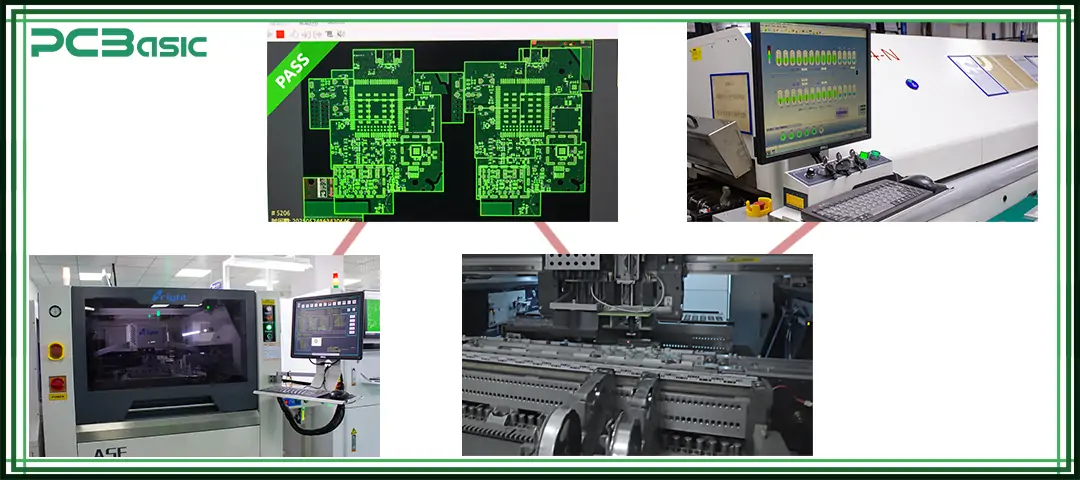
This is the first step in SMD PCB assembly. The operator uses a stainless-steel stencil to print solder paste onto the pads on the surface of the PCB. The solder paste is a mixture that contains flux and fine solder particles. It can temporarily stick SMD components, preparing for subsequent surface mount soldering.
After the solder paste printing is completed, an SPI machine is used for inspection. This is an indispensable automated inspection step in SMD PCB assembly. It mainly checks the following issues:
• Whether there are any pads without solder paste
• Whether the solder paste volume is too much or too little
• Whether the solder paste is accurately aligned with the pad positions
Only when the solder paste is printed accurately can the subsequent component mounting and soldering proceed smoothly.
The pick-and-place machine is the core equipment in SMD assembly. It precisely places various SMD components (such as resistors, capacitors, ICs and LEDs) on the solder paste through a high-speed vision alignment system. These components are usually supplied in the form of tape reels, trays or tubes, and are automatically picked up and mounted onto the corresponding pads by the pick-and-place machine.
This step demonstrates the highly automated features of SMD PCB assembly, significantly enhancing assembly efficiency and placement accuracy.
After all the components are mounted, the PCB will enter the reflow soldering stage. During this process, the circuit board will be sent into the reflow oven. The oven will heat the solder paste in stages according to the predefined temperature profile, causing it to melt and form a strong solder joint. Typical temperature profiles include:
• Preheat stage: gradually raises the temperature to avoid thermal shock
• Soak stage: holds the temperature steady to activate the flux
• Reflow stage: raises the temperature to the solder’s melting point, forming solder joints
• Cooling stage: quickly cools the board to solidify the joints
Some high-end equipment also uses a nitrogen environment to further prevent oxidation during soldering and improve the quality of surface mount soldering.
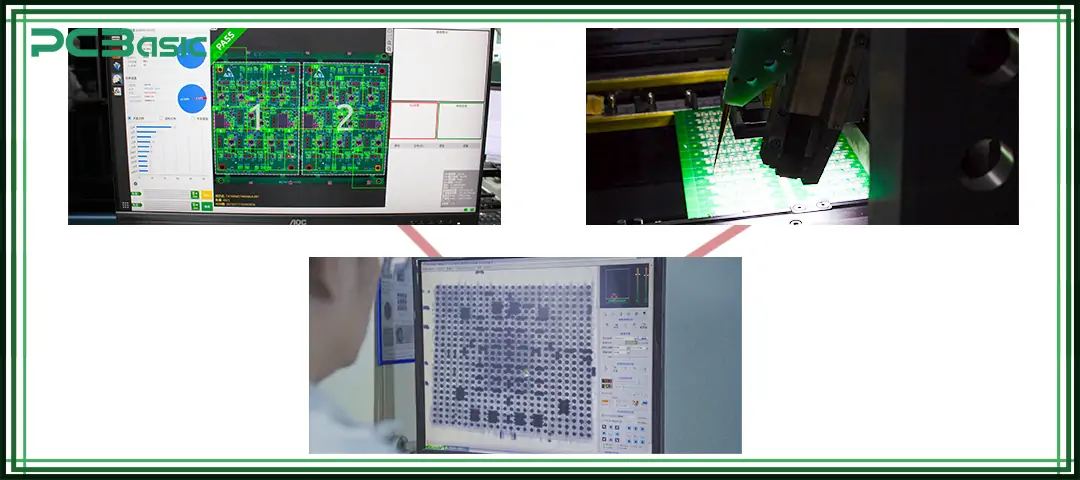
After the reflow soldering is completed, the circuit board will enter the AOI inspection stage. The AOI machine takes pictures of the board surface through multiple cameras and automatically determines the following contents:
• Whether components are placed in the correct positions
• Whether solder joints are good
• Whether there are visual defects such as missing, misaligned, or duplicated components
This process is an important step in the quality control of SMD PCB assembly and can effectively prevent defective products from moving to the next process.
For SMD PCB assemblies containing bottom-terminated components such as BGA and QFN, ordinary AOI cannot identify hidden solder joints. Therefore, X-ray equipment is needed to inspect the inner structure and determine whether the joints are good or if there are issues like voids or shorts.
After all visual and structural inspections are completed, the circuit board will undergo functional testing. By applying power and simulating electrical signals, this step ensures that the SMD electronic product performs according to design specifications. This is the final step in the SMD PCB assembly process and ensures that the product operates properly before delivery to the customer.
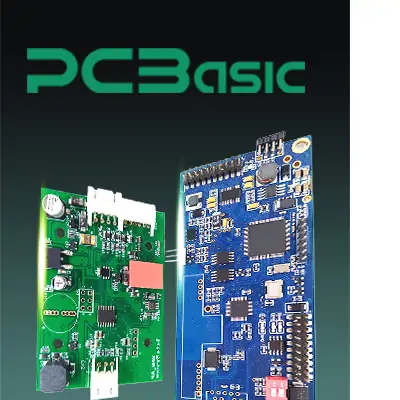
Time is money in your projects – and PCBasic gets it. PCBasic is a PCB assembly company that delivers fast, flawless results every time. Our comprehensive PCB assembly services include expert engineering support at every step, ensuring top quality in every board. As a leading PCB assembly manufacturer, we provide a one-stop solution that streamlines your supply chain. Partner with our advanced PCB prototype factory for quick turnarounds and superior results you can trust.
Proper design is essential for achieving a reliable and manufacturable SMD PCB assembly. The following are some best design practices:
It is recommended to use tools such as Altium Designer, KiCad, and Eagle to design optimized PCBs.
These software tools support exporting Gerber files and pick-and-place data required for manufacturing.
• Place SMD components with similar functions as close together as possible.
• Heat-sensitive components should be kept away from high-power ICs.
• Use symmetrical layouts to reduce board warping during reflow soldering.
• Avoid 90-degree angles to prevent signal reflection.
• Maintain consistent trace width to ensure impedance control.
• For high-speed SMD electronic products, use short and direct traces whenever possible.
Design thermal vias, heat sinks, or large copper areas near power-dense components.
This helps to effectively prevent overheating during the SMD PCB assembly process or during actual product operation.
High-quality solder mask prevents solder bridging and oxidation. It also improves the service life and visual quality of the PCB assembly.
THT, short for Through-Hole Technology, is a traditional electronic assembly method. Its principle is to insert electronic components with leads into pre-drilled holes on the PCB, and then solder them on the back side of the board using wave soldering or manual soldering. This creates electrical connections and secures the components in place. This method provides strong mechanical stability and is suitable for electronic products that require high reliability.
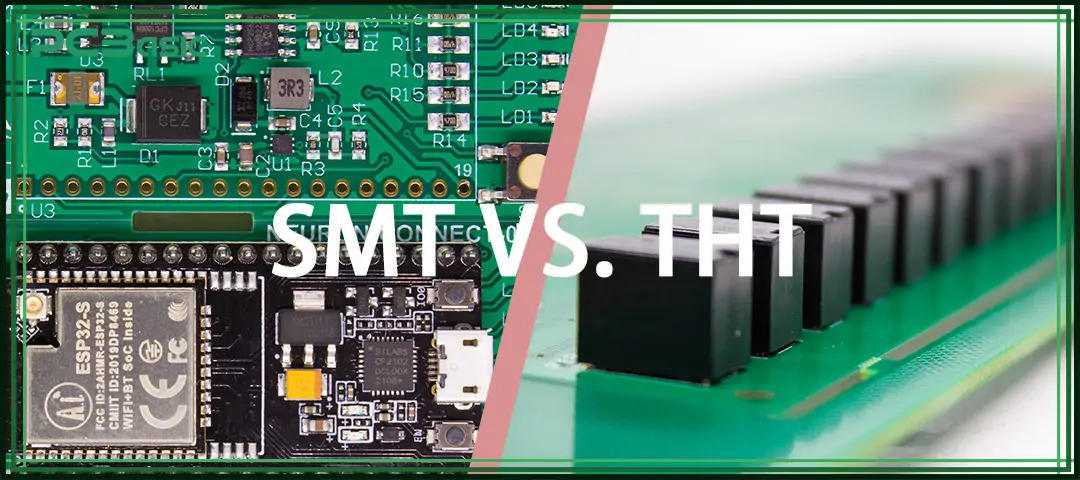
SMT vs THT: A Quick Comparison Table
|
Feature |
SMD (SMT PCB Assembly) |
THT (Through-Hole Technology) |
|
Component Size |
Small and compact |
Large and bulky |
|
Assembly Method |
Automated pick-and-place |
Manual or wave soldering |
|
Assembly Speed |
Fast, scalable |
Slower, labor-intensive |
|
Mechanical Strength |
Lower |
Higher—ideal for high-vibration applications |
|
Repairability |
More difficult |
Easier |
|
Cost Efficiency |
High for volume production |
Higher cost per unit |
|
Application Suitability |
Consumer electronics, telecom, IoT |
Aerospace, industrial, power electronics |
Despite some limitations, SMD PCB assembly remains the preferred choice for modern high-density printed circuit board assembly.
When performing SMD PCB assembly, choosing a reliable and experienced manufacturer is very important. It directly affects product quality, production efficiency, and delivery speed. PCBasic is a professional printed circuit board assembly service provider with many years of industry experience and advanced manufacturing capabilities, capable of consistently delivering high-quality SMD assembly services.
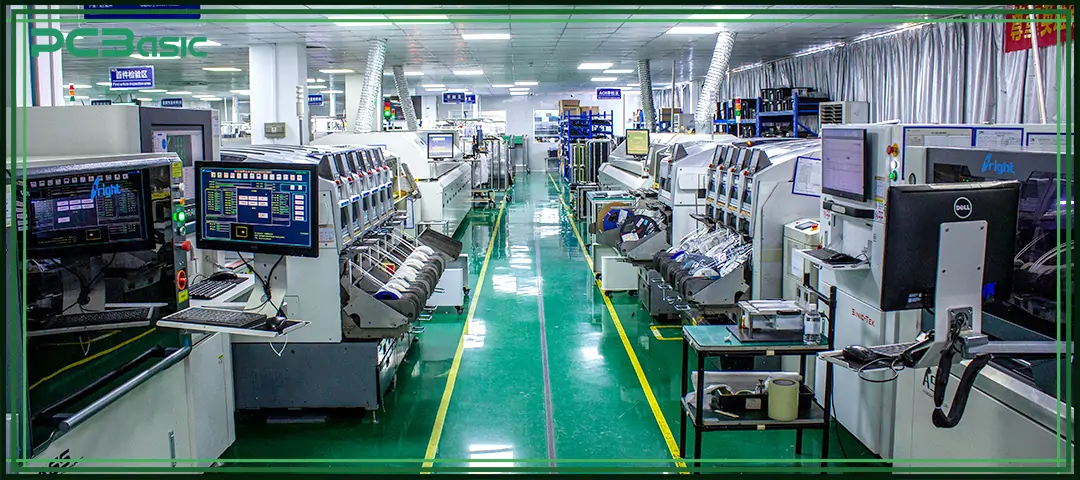
Here are the key reasons to choose PCBasic:
1. More than 10 years of experience in PCB design and project management. We ensure your surface mount design is manufacturable and suitable for automated production.
2. Multiple factories equipped with SMD PCB assembly production lines, including a small-batch facility in Shenzhen and a large-scale production plant in Huizhou, supporting everything from prototyping to mass production.
3. Self-owned stencil and fixture factory that enables delivery within 1 hour, ensuring fast and accurate solder paste printing—crucial for improving SMD assembly efficiency.
4. An intelligent central warehouse for electronic components. It ensures a stable supply of original and genuine SMD components, effectively reducing material shortages and delivery delays.
5. One-click BOM import and instant quotation system to simplify the procurement process, accelerate assembly progress, and shorten time-to-market.
6. Certified with multiple international quality standards: ISO13485, IATF 16949, ISO9001, ISO14001, and UL. Also, an IPC member, ensuring that every SMD PCB assembly board meets international standards.
Whether your project involves consumer electronics, industrial automation, or medical devices using SMD electronic products, PCBasic can provide one-stop support from design to delivery with its professional engineering team, complete facilities, and strict quality control for your surface mount technology (SMT) project.
From smartphones to aerospace equipment, SMD PCB assembly is a key part of modern electronic products. Mastering each process step—from stencil printing to reflow soldering—and applying proper design can help you build reliable, high-performance circuit boards.
Whether you are an engineer optimizing a prototype or a company looking for a suitable manufacturer, understanding and mastering the SMD PCB assembly process is a critical foundation for product success.
1. What is the difference between SMT and SMD?
SMT (Surface Mount Technology) is the process or method used, while SMD (Surface Mount Device) refers to the actual component mounted using that method. Both are key elements of SMD PCB assembly.
2. Can I assemble SMD PCBs at home?
Yes! With tools like solder paste, a stencil, tweezers, and a hot air gun, you can do basic SMD assembly at home—especially for prototypes and low-volume builds.
3. What’s the best solder paste for beginners?
Leaded solder paste like Sn63Pb37 is easier to work with due to its lower melting point and better wetting. Brands like Chip Quik SMD291AX are great for beginners in SMD PCB assembly.
4. Do I need a reflow oven, or is a hot air gun enough?
For small-scale or prototype PCB assemblies, a hot air gun works fine. However, a reflow oven offers better temperature control and consistency for batch production.
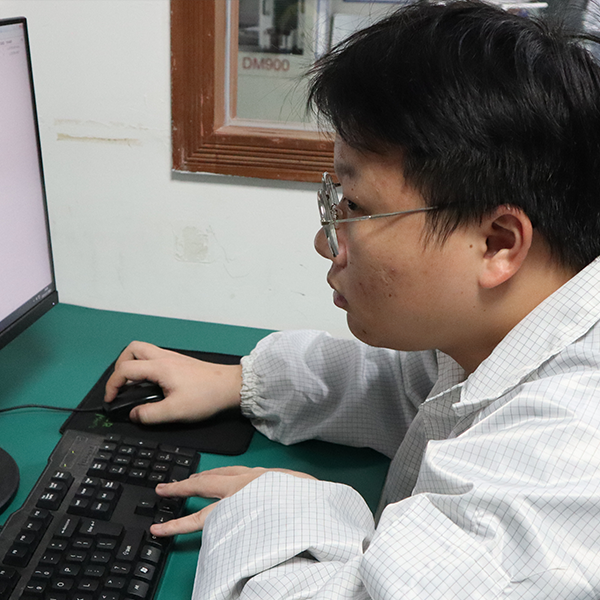
Assembly Enquiry
Instant Quote
Phone contact

+86-755-27218592
In addition, we've prepared a Help Center. We recommend checking it before reaching out, as your question and its answer may already be clearly explained there.
Wechat Support

In addition, we've prepared a Help Center. We recommend checking it before reaching out, as your question and its answer may already be clearly explained there.
WhatsApp Support

In addition, we've prepared a Help Center. We recommend checking it before reaching out, as your question and its answer may already be clearly explained there.
